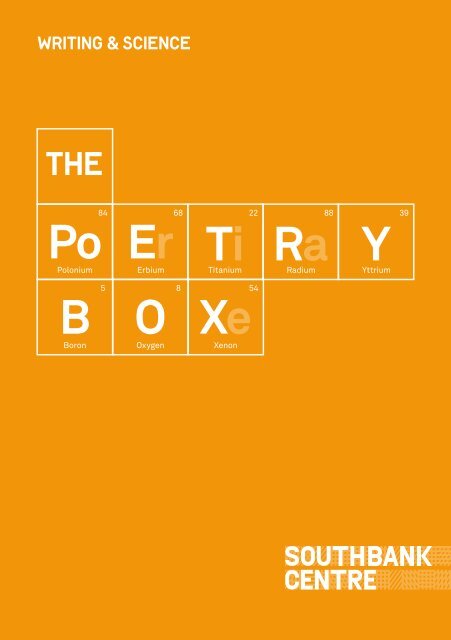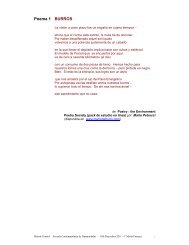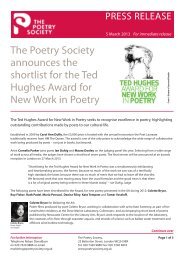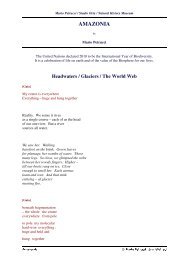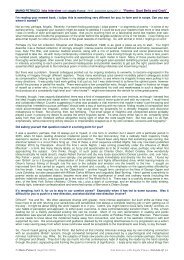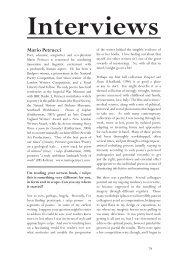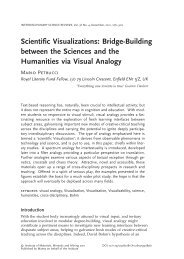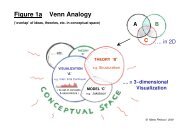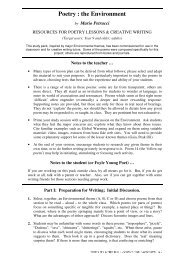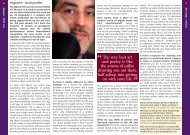Here - Mario Petrucci
Here - Mario Petrucci
Here - Mario Petrucci
You also want an ePaper? Increase the reach of your titles
YUMPU automatically turns print PDFs into web optimized ePapers that Google loves.
Writing & Science<br />
The<br />
88 39<br />
Po84<br />
Er68<br />
Ti22<br />
Ra Y<br />
Polonium Erbium Titanium Radium Yttrium<br />
B<br />
5<br />
Boron<br />
O<br />
8 54<br />
Xe<br />
Oxygen<br />
Xenon
Writing & Science<br />
THE POETRY BOX<br />
Po84<br />
Contents<br />
Introduction 2<br />
Two Warm-Ups 4<br />
Activity 1: Metaphor-Making 5<br />
Activity 2: Watch That Title! 7<br />
Activity 3: Mini-Worlds 11<br />
Activity 4: Random Numbers 13<br />
Er68<br />
B<br />
5<br />
Ti22<br />
O<br />
8<br />
Ra88<br />
Xe54<br />
Y<br />
39<br />
Both scientist and poet can nurture<br />
a deeper awareness of what’s around<br />
us - and in us. These writing exercises<br />
stimulate authentic connections<br />
between science and poetry, but they<br />
go way beyond ‘science + poetry’ to<br />
‘science x poetry’. The Poetry Box is<br />
a ‘creativity catalyst’, sparking fresh<br />
ways to re-cognise and re-create some<br />
corner of your own observable world.<br />
<strong>Mario</strong> <strong>Petrucci</strong> / Saison Poetry Library (2010)<br />
This mini-residency was commissioned as part of the<br />
‘See Further’ Poetry & Science Project, run in association<br />
with The Royal Society/ Southbank Centre Festival of<br />
Science and Arts.<br />
<strong>Mario</strong> <strong>Petrucci</strong> is an award-winning poet, scientist and<br />
creative writing tutor.<br />
mariopetrucci.com<br />
2
from a to a<br />
or Getting Nowhere<br />
finding the freeway<br />
to myself i put my foot<br />
down to my own motive<br />
floorboards asking the rear<br />
-view what to do<br />
next<br />
it said<br />
brother<br />
the faster you<br />
eat me up the more you<br />
leave behind – you’ll see<br />
more of me slower so why not<br />
pull over ’cause this road is going<br />
backwards and your incessant<br />
tyres are speeding up<br />
the world<br />
Pr<br />
0<br />
Preparation<br />
Two WARM-UPS<br />
1 Make a list of thoughts that occur to you when<br />
you see or hear the word science.<br />
Your list can include ideas, associations, memories<br />
(lab experiments, driving past a power station,<br />
breathing petrol fumes, sci-fi films, famous<br />
scientists, etc.) – anything you like.<br />
When you’ve got at least six entries, do the same<br />
again for the word poetry.<br />
If you’re working in a group, compare and discuss<br />
your lists.<br />
What do they reveal?<br />
2 Invent a strange new word that sounds ‘scientific’.<br />
Now imagine a possible definition for that word.<br />
Write your definition down, carefully, as though<br />
you were going to submit it to an encyclopaedia.<br />
<strong>Mario</strong> <strong>Petrucci</strong><br />
3<br />
S<br />
5<br />
Stanza<br />
Ve7<br />
Verse<br />
R<br />
12<br />
Rhyme<br />
4
M<br />
1<br />
Metaphor<br />
METAPHOR-MAKING<br />
Metaphor is crucial to poetry. Put simply, it usually<br />
involves talking about one thing in terms of something<br />
else (e.g. silver bird for aeroplane or grey rind for a<br />
miner’s clothes).<br />
Good metaphors often surprise us, making connections<br />
we don’t expect; but we recognise in them a rich<br />
and profound truth – even if we can’t always put our<br />
finger on what that truth is. In fact, a metaphor’s<br />
deepest effects might occur because we can’t<br />
explain it away rationally.<br />
In this exercise, you won’t be writing a poem. Instead,<br />
you’ll explore one way to move towards metaphor,<br />
simply by using the things that surround you. <strong>Here</strong>,<br />
the focus is on modern (or ‘scientific’) materials; but,<br />
actually, any kind of item can be used.<br />
1 Look around you. Make a list of objects that<br />
technology has helped to create.<br />
Each item should include the object and the material<br />
it’s made from, separated by ‘of’, like this:<br />
A pane of glass A wall of brick<br />
A carpet of fibres A roof of zinc<br />
(Assume that most materials like brick and glass<br />
have some link to modern technology.)<br />
Co6<br />
Couplet<br />
2 Extend your list to things that aren’t in your field<br />
of view.<br />
Again, these should arise from a technological<br />
process (tables of plastic, a haze of pollution,<br />
stockings of nylon, etc).<br />
3 Now, for each item in your list, cross out the<br />
material and replace it with any emotion of your<br />
choice (examples below).<br />
Don’t worry if some of them don’t make obvious sense…<br />
A pane of certainty<br />
A haze of jealousy<br />
A roof of confidence<br />
Stockings of anger<br />
If you need to change any words slightly so they fit<br />
(or sound) better, that’s okay.<br />
4 You have now created a kind of poetic imagery,<br />
a form of metaphor.<br />
Which items in your final list do you like most (or<br />
least)? Look more closely – might some of the most<br />
bizarre or confusing items actually be the most<br />
interesting? Why / why not?<br />
A<br />
9<br />
Alliteration<br />
5<br />
6
Ti<br />
2<br />
Title<br />
The Moon<br />
It is silvery.<br />
It has craters all over it.<br />
Wolves speak to it.<br />
It shouldn’t blind you.<br />
It causes the tides…<br />
WATCH THAT TITLE !<br />
1 Examine the scientific objects on pages 9 and 10.<br />
Choose one you like.<br />
2 At the top of a sheet of paper, write down the name<br />
of your chosen object – as a title.<br />
3 Underneath that title, describe your item plainly,<br />
using every sense you can (not just the visual).<br />
Focus on its most simple physical features; keep to<br />
the basics of what it does.<br />
Don’t mention your item again by name, but don’t be<br />
afraid to make observations that are really obvious,<br />
or that you’re not sure about. The important thing is<br />
to build a list of short, punchy statements about it.<br />
<strong>Here</strong> are a few examples to help you…<br />
Sulphur<br />
It’s a yellow powder.<br />
Burning, it smells horrible<br />
– worse than hell.<br />
Don’t breathe it in.<br />
Sometimes, it can heal you…<br />
DNA<br />
It is invisible to the naked eye.<br />
Without it, we couldn’t exist.<br />
We try to unravel its secrets.<br />
It is two snakes embracing.<br />
It is used to identify you…<br />
If you get stuck, ask for help or do some quick<br />
research in books or online.<br />
Anger<br />
Falling in love<br />
Loneliness<br />
Crime<br />
Duty<br />
Fate<br />
4 This is a key moment. Cross out the title of your piece.<br />
Next, replace it with any of the words given below<br />
(these are emotions and other abstract nouns):<br />
Jealousy<br />
Pride<br />
Curiosity<br />
War<br />
Memory<br />
Justice<br />
THE MOON luck<br />
It is silvery.<br />
It has craters all over it.<br />
Wolves speak to it.<br />
It shouldn’t blind you.<br />
It causes the tides…<br />
Happiness<br />
Fear<br />
Friendship<br />
History<br />
Decay<br />
Sleep<br />
Regret<br />
Confidence<br />
Boredom<br />
Advice<br />
Luck<br />
Death<br />
Hope<br />
Respect<br />
Surprise…<br />
News<br />
Logic<br />
Time<br />
Try to choose a new title that gives strange or exciting<br />
effects. <strong>Here</strong> are some examples:<br />
SULPHUR pride<br />
It’s a yellow powder.<br />
Burning, it smells horrible<br />
– worse than hell.<br />
Don’t breathe it in.<br />
Sometimes, it can heal you…<br />
DNA sleep<br />
It is invisible to the naked eye.<br />
Without it, we couldn’t exist.<br />
We try to unravel its secrets.<br />
It is two snakes embracing.<br />
It is used to identify you…<br />
5 You can leave the new piece exactly as it is,<br />
or try to improve it.<br />
Perhaps it builds more convincingly if you change<br />
the order of the lines? Maybe it’s stronger with<br />
something added or cut out? You might feel some<br />
lines don’t really work under the new title (how<br />
can sleep be ‘used to identify you’?) – or are these<br />
‘wrong’ bits some of the best of all?<br />
7<br />
8
gunpowder<br />
magnet<br />
coral<br />
blood<br />
Fossil<br />
Amoeba<br />
rewritable CD<br />
silicon chip<br />
orchid<br />
9<br />
10
11<br />
Mi3<br />
Mini-worlds<br />
MINI-WORLDS<br />
Inside the Poetry Box is an envelope marked ‘SLIDES’.<br />
Pick any slide from the envelope – it doesn’t matter<br />
which – and slot it carefully into the viewing panel at<br />
one end of the box.<br />
Take a good look at it, using the eyeholes at the other<br />
end of the box. Don’t be distracted by what the image<br />
is ‘in real life’. Instead, think of it as a brand new<br />
planet floating in space…<br />
Your mission. You’re a top space explorer. The slide<br />
you’ve just been looking at is what you can see, today,<br />
from your spaceship. No human has ever been here,<br />
so Earth HQ wants a report. You’ll need to write this<br />
down, as you go, describing everything in detail. Use<br />
good, clear sentences, as if your words were being<br />
beamed back to Earth ‘live’ for global TV.<br />
The planet. First, transport yourself down to the<br />
surface. What do you see when you look up, down,<br />
towards the horizon? What is the landscape like?<br />
Note the quality of the light, the peculiar weather<br />
systems. Write everything down, straight into<br />
your report.<br />
Sensors on! As a trained astronaut, you know there’s<br />
far more to new planets than what you can see.<br />
Are there strange sounds and (if the air is breathable)<br />
smells? Do you detect unusual temperatures,<br />
pressure and humidity – or ominous tremors<br />
underfoot? Use all your senses, and your clever<br />
instruments, to create a vivid record of the scene.<br />
S<br />
5<br />
Stanza<br />
Life? Decide quickly: is this planet a lot like Earth; or<br />
is it violent, barren or weird? Most importantly, does<br />
it support living things? (If so, they don’t have to be<br />
green aliens!) What about plants, animals? Are there<br />
bizarre forms of life that seem like science fiction?<br />
The incident. Suddenly, something dramatic<br />
happens. Describe the incident, in detail, in your<br />
report. If you’re still alive afterwards, add some final<br />
words on how your mission ends. Should earthlings<br />
visit this planet, or stay well clear?<br />
Name it. Does the planet already have a name? If not,<br />
as its discoverer you get to make one up. Does your<br />
name reflect the planet’s character or inhabitants in<br />
some way?<br />
Reporting back. When your report is complete,<br />
check it. Then read it to the rest of the group. Having<br />
read it out loud, are there any changes you’d now like<br />
to make?<br />
Finally… a poem. Turn the best bits of your report<br />
into a poem. It doesn’t have to rhyme! If it helps, stick<br />
to short lines and simple phrases. The poem’s title is<br />
the planet’s name.<br />
If you have time, pick another slide and do the exercise again<br />
for that new planet. Create a second report and poem.<br />
The images in the slides are produced at huge magnification<br />
(i.e. very close up). For those of you who really want to know<br />
what you were looking at, see back page.<br />
Ve7<br />
Verse<br />
12
R<br />
4<br />
Random<br />
RANDOM NUMBERS<br />
1 Draw a table like the one below and fill columns<br />
A and B with random numbers between 1 and 20.<br />
S<br />
P<br />
S<br />
P<br />
S<br />
P<br />
2 Now find the envelope marked Texts in the Poetry<br />
Box. Select one Scientific Text (marked S) and one<br />
Poetry Text (marked P).<br />
3 Each pair of numbers in your table is a ‘grid<br />
reference’ pointing to random words in the texts.<br />
A = the PAGE number and B = the LINE number,<br />
like this:<br />
S<br />
P<br />
A<br />
A<br />
B<br />
Page<br />
6<br />
13<br />
B<br />
line<br />
11<br />
14<br />
s = science book:<br />
Page 6, Line 11<br />
p = Poetry book:<br />
Page 13, Line 14<br />
e.g. ‘...an isotope of<br />
radon. Normally...’<br />
e.g. ‘...run quick pulses<br />
of electric blood...’<br />
Use this system to fill your table with lines from<br />
the texts (be sure to use the science text for ‘S’ rows,<br />
and the poetry text for ‘P’ rows).<br />
Note: if, for any reason, the numbers don’t work<br />
(e.g. the page is blank, or there aren’t enough lines),<br />
don’t worry. Just leave the space blank, or try<br />
a different book.<br />
R<br />
12<br />
Rhyme<br />
4 When completed, read your table as a single piece<br />
of crazy text.<br />
How can you use it to generate a short piece of<br />
writing? Discuss the possibilities with your group, or<br />
try one of the suggestions below.<br />
(a) Use any word or phrase in the table as a ‘trigger’,<br />
or starting point.<br />
(b) Respond to any word or phrase that catches your<br />
eye (perhaps it provokes a new idea, or evokes<br />
a memory).<br />
(c) Look for any kind of pattern in your table: a glimpse<br />
of a strange story or conversation, or a fragment<br />
of a character. Do any phrases collide to create<br />
something unexpected or surreal? It doesn’t have<br />
to ‘make sense’: what’s important is that you get<br />
thinking. Whatever you find, however slight, try<br />
to fill in the gaps or develop it in some way.<br />
5 Create another (blank) table, and fill it in using<br />
two books from your school library or local library<br />
(one scientific, the other poetry). Use your new<br />
table to repeat the exercise.<br />
Co6<br />
Couplet<br />
A<br />
9<br />
Alliteration<br />
13<br />
14
Mini-worlds slides<br />
Slide A: Bacteria (photographer: Bensik Ianiri)<br />
Slide B: Lime Tree Leaf (photographer: Kriss Szkurlatowski)<br />
Slide C: Butterfly Scales<br />
Slide D: Butterfly Wings<br />
Slide E: Lavender pollen on Stigma (photographer: Camelia Maier)


